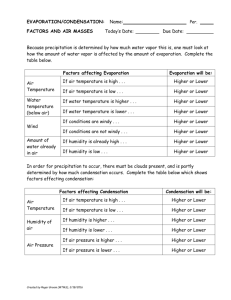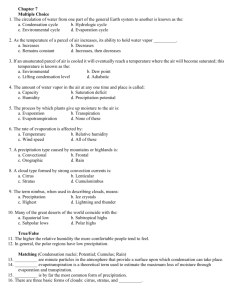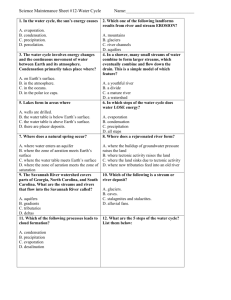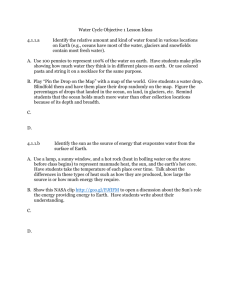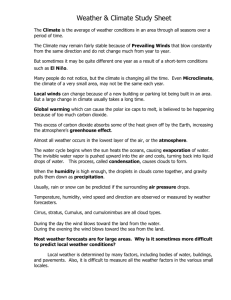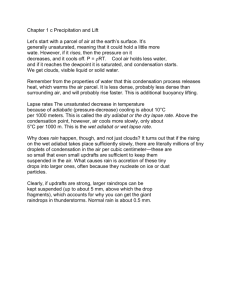What Is Condensation - Interstate Building Materials Inc.
advertisement
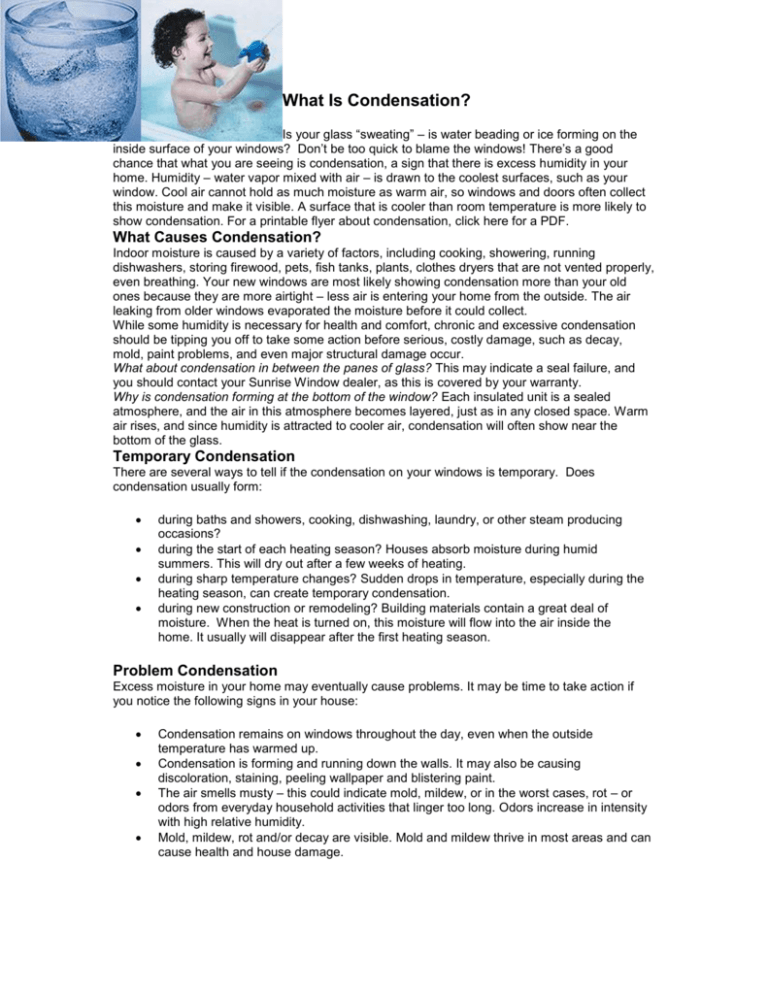
What Is Condensation? Is your glass “sweating” – is water beading or ice forming on the inside surface of your windows? Don’t be too quick to blame the windows! There’s a good chance that what you are seeing is condensation, a sign that there is excess humidity in your home. Humidity – water vapor mixed with air – is drawn to the coolest surfaces, such as your window. Cool air cannot hold as much moisture as warm air, so windows and doors often collect this moisture and make it visible. A surface that is cooler than room temperature is more likely to show condensation. For a printable flyer about condensation, click here for a PDF. What Causes Condensation? Indoor moisture is caused by a variety of factors, including cooking, showering, running dishwashers, storing firewood, pets, fish tanks, plants, clothes dryers that are not vented properly, even breathing. Your new windows are most likely showing condensation more than your old ones because they are more airtight – less air is entering your home from the outside. The air leaking from older windows evaporated the moisture before it could collect. While some humidity is necessary for health and comfort, chronic and excessive condensation should be tipping you off to take some action before serious, costly damage, such as decay, mold, paint problems, and even major structural damage occur. What about condensation in between the panes of glass? This may indicate a seal failure, and you should contact your Sunrise Window dealer, as this is covered by your warranty. Why is condensation forming at the bottom of the window? Each insulated unit is a sealed atmosphere, and the air in this atmosphere becomes layered, just as in any closed space. Warm air rises, and since humidity is attracted to cooler air, condensation will often show near the bottom of the glass. Temporary Condensation There are several ways to tell if the condensation on your windows is temporary. Does condensation usually form: during baths and showers, cooking, dishwashing, laundry, or other steam producing occasions? during the start of each heating season? Houses absorb moisture during humid summers. This will dry out after a few weeks of heating. during sharp temperature changes? Sudden drops in temperature, especially during the heating season, can create temporary condensation. during new construction or remodeling? Building materials contain a great deal of moisture. When the heat is turned on, this moisture will flow into the air inside the home. It usually will disappear after the first heating season. Problem Condensation Excess moisture in your home may eventually cause problems. It may be time to take action if you notice the following signs in your house: Condensation remains on windows throughout the day, even when the outside temperature has warmed up. Condensation is forming and running down the walls. It may also be causing discoloration, staining, peeling wallpaper and blistering paint. The air smells musty – this could indicate mold, mildew, or in the worst cases, rot – or odors from everyday household activities that linger too long. Odors increase in intensity with high relative humidity. Mold, mildew, rot and/or decay are visible. Mold and mildew thrive in most areas and can cause health and house damage. Interior Condensation Interior condensation forms on the inside pane of the glass within your home. This is the type of condensation most homeowners notice and become concerned about. It usually forms in the winter, especially at the beginning of the heating season. As the outside temperature drops, the inside surface will also get cooler; therefore, condensation will form at lower relative humidity on cold days. The colder the air outside, the more likely condensation is to occur. You have a great deal of control over interior condensation. See the Reducing Condensation for ways to decrease the occurrence of this kind of condensation. Exterior Condensation Conversely, exterior condensation, which forms on the outside pane of the window, typically occurs in the summer. This type of condensation can occur for several reasons: the glass temperature drops below the dew point temperature of the outside air, the air is still, there is a high relative humidity, there is a clear night sky, or there are plants located near your window. While unsightly, exterior condensation should not concern you since it usually evaporates as the day wears on and will not affect the interior of your home. Since you cannot control the relative humidity outside your home, the only step you can take to combat exterior condensation is to warm the inside surface of the window, as this is a way to warm the outside surface. Seeing exterior condensation on those rare days should be reassurance that your windows are doing their job: keeping your heating and cooling in your home where it belongs and saving you money. Condensation & Health Improper temperature and humidity can cause comfort and health concerns. Warm, humid environments encourage the growth of molds and fungi, which can lead to allergic reactions. Dry environments can irritate sinus linings and can progress to a sinus infection. The best way to combat this is to achieve the appropriate balance of temperature and moisture in your home. See the table below for guidance. Acceptable Ranges of Temperature & Relative Humidity During Winter (in °F) The humidity level that should be maintained in your home during the winter varies with the outside temperature. The colder it is outside, the lower the humidity level must be inside your home. All major manufactures of humidifiers list the recommended humidity settings based on outside temperatures. The following guideline is recommended by every major manufacturer of windows and humidifiers. Outside Temperature Relative Humidity -20° F 15% or less -10° F 15% to 20% 0° F 20% to 25% +10° F 25% to 30% +20° F 30% to 35% Climate & Other Factors Northern and Midwest Regions of the U.S., or those places where the temperature average for January is 35° F or colder, tend to have more occurrences of condensation. The greater the extremes between outdoor and indoor temperatures, the more likely moisture will become visible on your windows. Bay, bow, and garden windows often create opportunities for condensation to show because air circulation is frequently limited and their protrusion from the insulated house wall generally makes them a few degrees cooler. Heavy window treatments also limit airflow and increase the likelihood of condensation. Reducing Condensation Now that you know the what and why of condensation, it’s time to learn how to reduce the conditions that cause it, especially if you are concerned about the effects of that excess moisture on your home and health. There are several steps you can take in three main areas: 1. Reduce Moisture Sources Stop or severely limit the use of humidifiers, or adjust them to the appropriate setting. Run a dehumidifier if needed. Limit plants, aquariums, and pets. If you care for a lot of plants, group them in one sunny room and avoid over watering. Have your gas appliances checked, if you have not recently. Malfunctioning gas appliances can deliver excessive water vapor into the air along with more dangerous contaminants. Be sure you have a carbon monoxide alarm. Store firewood outside. Eliminate plumbing leaks. Don’t air-dry clothes indoors. Correct grading and drainage problems around exterior of your home. 2. Increase Ventilation Open windows for a few minutes each day, particularly after steam-producing activities such as showering/bathing, laundry, and cooking. Heat loss will be minimal. Run kitchen, bathroom, and other fans longer and more often. Improve or add a ventilation system in your home through attic, roof and soffit venting. Ensure that everything vents to the outside. Open blinds and drapes. Heavy window coverings restrict the flow of warm air over the interior glass surface. Operate ceiling fans to improve air circulation. 3. Increase Air Temperature Raise the temperature inside the house. Insulate under the seat and over the head of bay, bow, and garden windows to keep window area warmer. Direct warm-air supply ducts toward windows or even use a fan for increased air circulation at windows. If you continue to have alarming condensation and other moisture problems and you have taken the steps above, it may be beneficial to consult a heating contractor specialist for further cures. Independent Resources Clearing the Air About Condensation, Tom Feiza, Home Tips Home Moisture, Home Energy Guide, Minnesota Department of Commerce Energy Information Center Indoor Air Quality – Temperature and Humidity, Environmental Health & Safety, Bowling Green State University Council Notes on Moisture Control, University of Illinois Small Homes Council, Building Research Council

